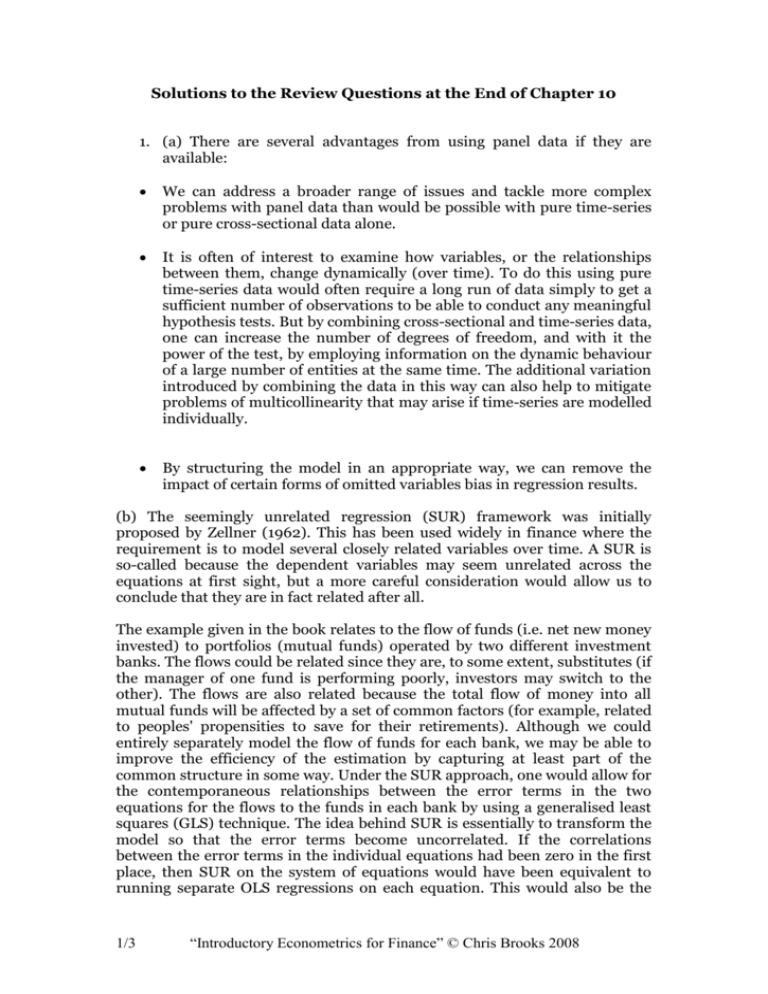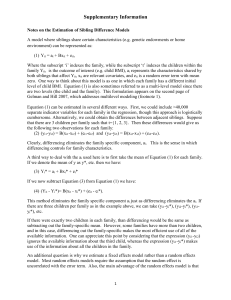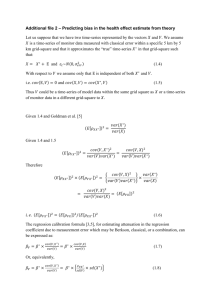Chapter 10 - Cambridge University Press
advertisement

Solutions to the Review Questions at the End of Chapter 10 1. (a) There are several advantages from using panel data if they are available: We can address a broader range of issues and tackle more complex problems with panel data than would be possible with pure time-series or pure cross-sectional data alone. It is often of interest to examine how variables, or the relationships between them, change dynamically (over time). To do this using pure time-series data would often require a long run of data simply to get a sufficient number of observations to be able to conduct any meaningful hypothesis tests. But by combining cross-sectional and time-series data, one can increase the number of degrees of freedom, and with it the power of the test, by employing information on the dynamic behaviour of a large number of entities at the same time. The additional variation introduced by combining the data in this way can also help to mitigate problems of multicollinearity that may arise if time-series are modelled individually. By structuring the model in an appropriate way, we can remove the impact of certain forms of omitted variables bias in regression results. (b) The seemingly unrelated regression (SUR) framework was initially proposed by Zellner (1962). This has been used widely in finance where the requirement is to model several closely related variables over time. A SUR is so-called because the dependent variables may seem unrelated across the equations at first sight, but a more careful consideration would allow us to conclude that they are in fact related after all. The example given in the book relates to the flow of funds (i.e. net new money invested) to portfolios (mutual funds) operated by two different investment banks. The flows could be related since they are, to some extent, substitutes (if the manager of one fund is performing poorly, investors may switch to the other). The flows are also related because the total flow of money into all mutual funds will be affected by a set of common factors (for example, related to peoples' propensities to save for their retirements). Although we could entirely separately model the flow of funds for each bank, we may be able to improve the efficiency of the estimation by capturing at least part of the common structure in some way. Under the SUR approach, one would allow for the contemporaneous relationships between the error terms in the two equations for the flows to the funds in each bank by using a generalised least squares (GLS) technique. The idea behind SUR is essentially to transform the model so that the error terms become uncorrelated. If the correlations between the error terms in the individual equations had been zero in the first place, then SUR on the system of equations would have been equivalent to running separate OLS regressions on each equation. This would also be the 1/3 “Introductory Econometrics for Finance” © Chris Brooks 2008 case if all of the values of the explanatory variables were the same in all equations - for example, if the equations for the two funds contained only macroeconomic variables. (c) A balanced panel has the same number of time-series observations for each cross-sectional unit (or equivalently but viewed the other way around, the same number of cross-sectional units at each point in time), whereas an unbalanced panel would have some cross-sectional elements with fewer observations or observations at different times to others. 2. (a) The fixed effects model for some variable yit may be written yit xit i vit We can think of i as encapsulating all of the variables that affect yit crosssectionally but do not vary over time – for example, the sector that a firm operates in, a person's gender, or the country where a bank has its headquarters, etc. Thus we would capture the heterogeneity that is encapsulated in i by a method that allows for different intercepts for each cross sectional unit. This model could be estimated using dummy variables, which would be termed the least squares dummy variable (LSDV) approach. We would write this as yit xit 1 D1i 2 D2i 3 D3i N DN i vit where D1i is a dummy variable that takes the value 1 for all observations on the first entity (e.g., the first firm) in the sample and zero otherwise, D2i is a dummy variable that takes the value 1 for all observations on the second entity (e.g., the second firm) and zero otherwise, and so on. As it is written in the second of these two equations, this is now just a standard regression model and therefore it can be estimated using OLS. (b) An alternative to the fixed effects model described above is the random effects model, which is sometimes also known as the error components model. As with fixed effects, the random effects approach proposes different intercept terms for each entity and again these intercepts are constant over time, with the relationships between the explanatory and explained variables assumed to be the same both cross-sectionally and temporally. However, the difference is that under the random effects model, the intercepts for each cross-sectional unit are assumed to arise from a common intercept (which is the same for all cross-sectional units and over time), plus a random variable i that varies cross-sectionally but is constant over time. i measures the random deviation of each entity’s intercept term from the ‘global’ intercept term . We can write the random effects panel model as yit xit it 2/3 , it i vit “Introductory Econometrics for Finance” © Chris Brooks 2008 where xit is still a vector of explanatory variables, but here the heterogeneity (variation) in the cross-sectional dimension occurs via the i terms. Note that this framework requires the assumptions that the new cross-sectional error term, i, has zero mean, is independent of the individual observation error term, vit, has constant variance and is independent of the explanatory variables. (c) It is often said that the random effects model is more appropriate when the entities in the sample can be thought of as having been randomly selected from the population, but a fixed effect model is more plausible when the entities in the sample effectively constitute the entire population (for instance, when the sample comprises all of the stocks traded on a particular exchange). More technically, the transformation involved in the GLS procedure under the random effects approach will not remove the explanatory variables that do not vary over time, and hence their impact on yit can be enumerated. Also, since there are fewer parameters to be estimated with the random effects model (no dummy variables or within transform to perform), and therefore degrees of freedom are saved, the random effects model should produce more efficient estimation than the fixed effects approach. However, the random effects approach has a major drawback which arises from the fact that it is valid only when the composite error term, it, is uncorrelated with all of the explanatory variables. The assumption is more stringent than the corresponding one in the fixed effects case, because with random effects we thus require both i and vit to be independent of all of the xit. This can also be viewed as a consideration of whether any unobserved omitted variables (that were allowed for by having different intercepts for each entity) are uncorrelated with the included explanatory variables. If they are uncorrelated, a random effects approach can be used; otherwise the fixed effects model is preferable. A test for whether this assumption is valid for the random effects estimator is based on a slightly more complex version of the Hausman test described in Chapter 6. If the assumption does not hold, the parameter estimates will be biased and inconsistent. 3/3 “Introductory Econometrics for Finance” © Chris Brooks 2008











